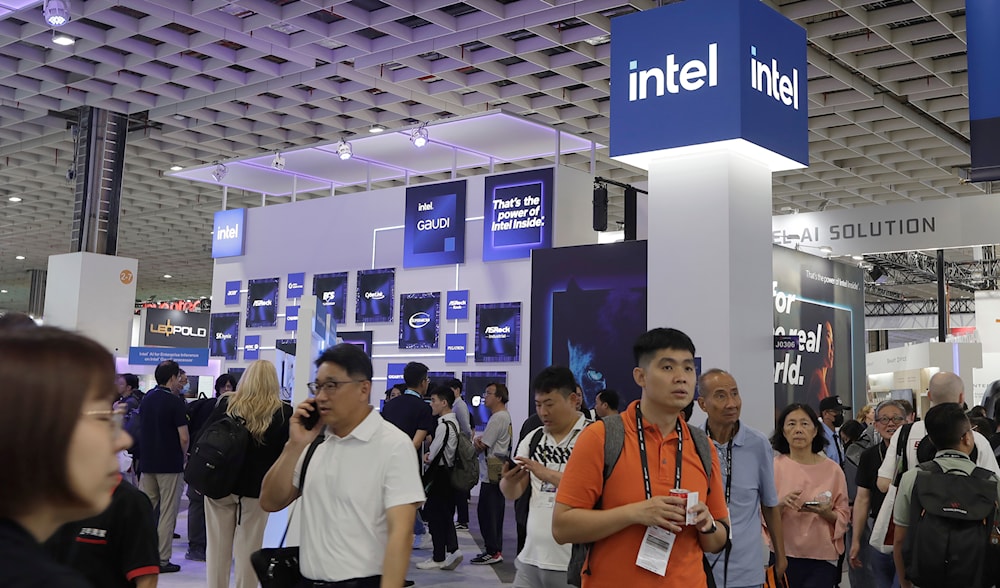US secures 10% ownership in Intel as Trump prods new industrial policy
The US will take a 10% equity stake in Intel under a Trump-backed deal converting CHIPS Act grants into ownership.
-

Visitors walk by Intel booth at the Computex Taipei exhibition, one of the world's largest computer and technology expos, in Taipei, Taiwan, Tuesday, May 20, 2025. (AP Photo/Chiang Ying-ying)
US President Donald Trump announced that the United States government will acquire a 10% equity stake in Intel, one of the world's most important chipmakers, marking one of the boldest interventions in corporate US in recent history.
The deal converts nearly $10 billion in government grants, initially given under the CHIPS Act, a federal program aimed at boosting domestic semiconductor production, into partial ownership of the company.
The government will purchase about 433 million shares of Intel at $20.47 each, below the market price, for a total of $8.9 billion. The stake comes with an option to buy an additional 5% in the future if Intel’s chip manufacturing arm, known as its foundry business, loses independence.
Once a global leader in semiconductor production, Intel has faced deep financial troubles. In 2024, the company reported an $18.8 billion annual loss, its worst performance since the 1980s.
Intel’s foundry business, its attempt to manufacture chips for outside clients, has become a money-losing division, with billions in quarterly losses. Despite heavy investment, Intel has struggled to secure major customers, falling far behind rivals like Taiwan’s TSMC and South Korea’s Samsung.
Beyond finances, Intel has also missed key technological shifts. The company largely sat out the artificial intelligence (AI) boom, leaving Nvidia to dominate that market, while also losing ground in its traditional markets to Advanced Micro Devices (AMD).
The role of the CHIPS Act
The CHIPS and Science Act, signed into law in 2022, was designed to strengthen the US' position in semiconductor production. At the time, the US produced only about 10% of the world’s chips, compared to nearly 40% in 1990. Meanwhile, about three-quarters of global chip manufacturing is concentrated in East Asia, raising concerns that the US economy and military could become vulnerable to supply chain disruptions.
The act provided $52.7 billion in incentives to semiconductor companies, of which Intel became the largest beneficiary, receiving nearly $11 billion in funding. However, the Trump administration’s decision to turn these grants into government ownership represents a fundamental shift in policy, ensuring that taxpayers directly contribute to Intel’s potential recovery.
Semiconductors are essential components in nearly every modern technology, from smartphones and laptops to fighter jets, satellites, and missile systems.
US officials argue that relying on foreign suppliers for advanced chips poses a national security risk, and Trump framed the Intel deal as part of a larger strategy to guarantee that the US can produce its own advanced microchips at home.
Commerce Secretary Howard Lutnick described the arrangement as “fair to Intel and fair to the American people,” stressing that the government’s stake is designed to be passive, without a seat on Intel’s board.
Intel’s downsizing in "Israel"
Intel’s struggles are not limited to the US. The company is undergoing its largest downsizing in more than a decade in "Israel," where its workforce has fallen from 12,000 in 2021 to below 9,000 in mid-2025. For the first time, job cuts have reached its flagship plant in Kiryat Gat, which produces chips using older technologies that are no longer competitive globally.
Intel has also suspended its massive $25 billion Fab 38 expansion project in the city, a move described by the Boycott, Divestment and Sanctions (BDS) movement as one of its biggest victories. These changes reflect Intel’s broader technological lag and financial strain, which have forced the company to cut costs globally.
The company’s leadership has also undergone major changes. Former CEO Pat Gelsinger was forced out in late 2024 after investors lost confidence in his strategy. He was replaced by Lip-Bu Tan in March 2025. Tan has focused on cost-cutting and securing external customers, moving away from the massive factory expansion plan pursued by his predecessor.

 4 Min Read
4 Min Read










